|
Regional History History of Timbering County Histories Calhoun County Franklin County Gadsden County Gulf County Jackson County Photos Maps Liberty County Wakulla County |
History: Jackson County
Pre-1565 Era
Jackson County received its earliest human inhabitants about 5000 to 1000 B.C. They were hunters and gatherers, living in small villages, which were very mobile, as the people followed food supply availability.
The Fort Walton civilization lasted from 900 AD to the mid-1700s. This civilization was centered along the Apalachicola and Chattahoochee Rivers and was agrarian in nature. The Fort Waltons were ancestors of the Apalachee, who occupied the region east of the Apalachicola when the Spanish arrived.
1565 - St. Augustine was founded.
This first Spanish settlement led to the string of Apalachee missions along the Panhandle that was Spain's claim to the southeastern U.S. lands.
1674 - Two Spanish missions established in what was-to-be Jackson County
The missions of San Carlos de los Chacatos and San Nicholas de Tolentino were established. All of the of the Spanish's Apalachee missions were destroyed by Colonel James Moore's raids in 1703 and 1704.
1693 - First European writing about Jackson county
The area encompassed by present-day Jackson County was mentioned by Governor Torres Y Ayaia, who reported pitching camp at a cave formed of limestone and a large spring of water. This spring was today's Blue Springs.
1763 - Spain ceded Florida to England in February 1763
This marked the end of the first Spanish regime. England divided Florida into two provinces, East and West Florida, with the Apalachicola River as the dividing line.
1776 - Florida remained loyal to England during the American Revolution.
1779 - The western section of West Florida fell back into Spanish hands
1783 - The British re-ceded the two provinces of Florida back to Spain.
1813 - Land rush into Jackson County
Removal of Indians from some 20 million acres, combined with the invention of the cotton gin in 1793, led to a land rush into the fertile Marianna lowlands.
1821 - U.S. acquires Florida from Spain
The Cession Treaty between the U.S. and Spain was signed in 1819 and ratified by the governments in 1820 and 1821. On July 10, 1821, the U.S. acquired Florida.
1822 - Florida becomes a U.S. territory
Florida became a territory on March 30, 1822 by Act of Congress. The first two Florida counties were Escambia and St. Johns, created on July 21, 1821. Legislative council created Jackson and Duval counties on August 12, 1822. By that time, Jackson County had 150 pioneer families. Little is known about the estimated 50 pre-territorial pioneers.
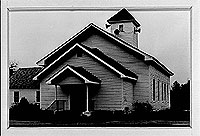 Campbellton Baptist Church. Photo courtesy Florida Photographic Archives. |
1827 - The City of Marianna and Webbville are founded.
Founded by Robert Beveridge, Marianna is the oldest incorporated town in Jackson County. It is believed that Marianna is named for Mr. Beveridge's wife, Anna Maria, with the two given names reversed. Marianna was know at the time as a “rich man's town” relative to Webbville.
Webbville was located about three miles northeast of Cottondale and grew from a “squatter settlement. ” Webbville was named for Col. James Webb, a member of the Legislative Council. Among the first semi-public academics in the Florida Territory was Webbville Academy, which opened on February 27, 1827, and was the first school in the county to be chartered by the Legislative Council.
1828 - Chipola Canal Company incorporated.
As early as 1825, pioneers were discussing a ship canal to link the Chipola and Apalachicola River with a deep-water harbor at St. Andrews' Bay. Promoters secured a charter from territorial legislature in 1828 and the Chipola Canal Company was incorporated in April 1828. Construction of the canal was never begun.
1829 - Jackson County seat controversy “resolved”
From 1822 until 1830, there was no permanent county seat. The first legislative council met at what is now Blue Springs. It came to a head in 1827. Although Webbville won at the polls in 1828, Congress had not granted authority to locate a town on school land reserve. By the time Congress gave them this authority in 1829, the Legislative Council had forced the courts to move to Marianna. As a result, the majority of the businesses moved to Marianna and Webbville became a ghost town. No specific enactment settled the issue; the county seat has just remained at Marianna.
1829 to early 1833 - Initial Establishment of banking industry in Jackson County
The Bank of West Florida (1829) and the Farmers Bank of Marianna (1833) were the second and ninth banks organized in the Territory of Florida. Many of these pioneer banks failed within a few years due to the economic depression in the late 1830's and early 1840's. After the failure of the pioneer banks, it took more than 50 years for commercial banking to resume in Jackson County.
1832 - Fayette County created
Fayette County included all parts of Jackson County lying east of the Chipola River and the apex formed by the confluence of the Chipola and Apalachicola River. The impetus behind the initial creation of this county is unclear but it was probably due to land speculation. The planters in the northern part of Fayette County objected and that portion of land was returned to Jackson County in 1833. The remaining residents of Fayette County then petitioned to be re-joined to Jackson County because their total population was then less than 100 qualified voters. The “lost county” was returned to Jackson County in 1834.
1834 - Marianna Academy was incorporated by Territorial legislature on February 6.
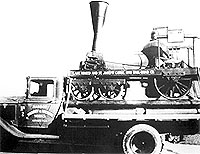 Replica of the first steam engine in Florida, constructed for the Lake Wimico - St. Joseph rail line. Photo courtesy Florida Photographic Archives. |
1839 - Jackson County delegates support the Florida Constitution
The Constitutional Convention was held in St. Joseph from December 3, 1838 to January 11, 1839. The Constitution passed in May of 1839 by 119 votes. Jackson County was the only county west of the Apalachicola River to support the Constitution. It was over six years before Florida was admitted to the Union along with Iowa, on March 3, 1845. The joint admittance was necessary to keep the balance of free and slave states.
1847 - First Marianna newspaper founded
The first Marianna newspaper was the Florida Whig in 1847. Other early papers included the Marianna Patriot and the Marianna Courier.
Pre-Civil War Era
In 1860, there were 14 churches in the county with their own buildings: nine Methodist, three Baptist, one Episcopalian, and one Presbyterian. An 1860 census showed five “common schools” with a total of 122 students, less than one quarter of white children of school age. Education was largely for the wealthy that could afford private tutors and out-of-state schools for their children. (The public school system was not established until 1868. School activities were suspended during the Civil War.)
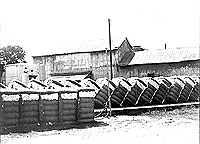 Baled cotton in Jackson County. Site is probably in Marianna or Graceville. Photo courtesy Florida Photographic Archives |
Civil War Era (1861 - 1865)
Florida was the third state to withdraw from the Union after Lincoln's election. The prosperous and conservative planters of Jackson County were not in favor of immediate secession. Florida withdrew on January 10, 1861 and was an “independent nation” for a month before becoming one of the Confederate States of America.
Salt production became a major industry for Jackson County residents during the war.
An estimated 500 Jackson County men fought for the Confederate Army between 1861 and 1865, about 10% of the total white population.
The Battle of Marianna is the most tragic and memorable event in Jackson County history. General Asboth of the Union wanted to capture the St. Andrews salt works by way of Marianna. The 200 Confederate troops, men and boys, fought about 500 Union troops. The Episcopal Church was burned in the battle.
Post Civil War (1865 - 1868)
After the Civil War, plantation owners were reduced to poverty, with many being land poor and unable to pay taxes. A crop failure in 1867 intensified this precarious situation.
Many businesses and hundreds of individuals were forced into bankruptcy. Many school and churches closed.
1869 - 1871 - Second Battle of Marianna / Jackson County War
Due to frustrations over changes due to Civil War came what has been called a “second rebellion” against authority, referred to by some as the “Second Battle of Marianna” or the “Jackson County War.” This period lasted from 1869 until 1871 and resulted in the death of over 150 men, women, and children, white and black, exceeding the casualties of the 1864 battle. Some were native whites but the majority was blacks and white Republicans.
1880 - 1900 - Jackson County Revivial
The 1880 to 1900 period for Jackson County was a period of revival for agriculture and business. The population grew from 14,372 to 23,337 in just 20 years. The county's first railroad was completed as well as the first bank since the early pioneer banks. Also, the county expanded its timber products. The railroad brought the communities of Cottondale, Sneads, and Grand Ridge.
In late 19th century, popular entertainment included croquet, tennis, and quarter horse racing, as well as cornet bands, thespian clubs, and traveling troops. Fishing, hunting, and canoeing were also popular. Favorite events included county fairs and horse races.
1882 - First railroad completed in Jackson County by the Pensacola and Atlantic line
1901 - Marianna Telephone Exchange becomes the first public utility in Jackson County.
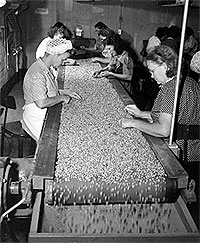 Employees grading peanuts at the Greenwood Products Company plant. Photo courtesy Florida Photographic Archives. |
1905 - Cottondale incorporated
Cottondale is located about 3 miles southwest of the original Webbville. It is at the junction of two rail lines and two major highways.
1900 - 1910
Dr. N.A. Baltzell had the first car in Jackson County and J.D. Smith began selling Buicks in 1908.
By the turn of the century, lumbering, extraction and manufacture of naval stores, and real estate transactions were a large part of the Jackson County economy. Marianna had the only high school in the county and Sneads had the only junior high school.
Jackson County was one of the largest cotton-producing counties in Florida from 1900 to 1915. With 2,927 farms in Jackson County in 1908, cotton was still the major money crop. The boll weevil decimated this industry. This led to a transformation of Jackson County agriculture from cotton to peanuts.
1910 - Jackson County sells bonds for road improvements
Jackson County was Florida's first county to issue bonds for road improvements. The county was a pioneer in modern highway financing by issuing $300,000 in bonds to build 800 miles of improved sand-clay roads in 1910.
1910 - 1920
The boll weevil decimated the cotton crop, with production declining from over 23,000 bales of cotton in 1913 to fewer than 2000 bales in 1916. This led to a transformation of Jackson County agriculture from cotton to peanuts. Jackson County became one of the largest peanut producing areas in the U.S. By 1920, peanuts were a new money crop. Among other crops replacing cotton were corn, wheat, rice, watermelon, and sugar cane.
By 1920, millions of board feet of lumber and thousands of barrels of turpentine and rosin had been shipped from Jackson County.
Sneads became the first special school district in Jackson County. By 1914, there were 13 special school districts. Special school districts were eliminated by an act of the Florida Legislature in 1947.
Marianna began building sidewalks and paving streets in 1915.
The first hospital in Marianna was opened by Dr. Baltzell about 1916 but the Baltzell Hospital itself was not completed until 1922.
1920 - Marianna approved street lighting and it was installed by 1921.
1927 - The Jackson County Floridian newspaper was established by J.C. Corcoran.
1920 - 1930
During the 1920's, Marianna began to make extensive public improvements, such as developing the Confederate Memorial Park downtown, and paving it for automobile usage and parking.
Improved roads and increased number of cars reduced the numbers and sizes of many small towns which emerged in the early 1900's, such as Cypress, Bascom, Alford, Malone, Inwood, Alliance, Compass Lake, Dudley, Lovedale, Glass, Jacob, and Sink Creek.
Between 1920 and 1927, much of Florida experienced a time of frenzied real estate boom and economic growth but Jackson County did not. In Jackson County, farming and forest industries remained the most important economic pursuits.
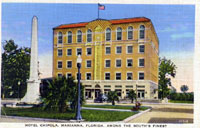 Postcard of Hotel Chipola, courtesy Florida Photographic Archives. |
1930 - 1940
By 1930, governments were overwhelmed with delinquent taxes due to the stock market crash of 1929. Some of the projects undertaken during this time include the construction of a municipal airport in Marianna, a roadway between Cottondale and Graceville, a sewage disposal plan, and the golf course by Florida Caverns State Park.
A number of natural disasters in the 1930's contributed to increasing economic problems. Fires in Cottondale and Graceville in 1932 destroyed much of their business districts. The freeze of 1935 wiped out the 3000 acres of Satsuma groves. The Marianna Fruit Company and the Hotel Chipola Corporation went bankrupt in the mid-1930's.
The Forest industry began to change because most of the timberlands were already cut. The USDA began promoting a replanting program and Jackson County joined about 1935. In 1935, Alfred Dupont bought 242,000 acres of pineland along the Gulf Coast, the Apalachicola Northern Railroad, and Port St. Joe, where a huge paper mill was built for pulpwood. The decision by newspaper publishers that pulpwood made the most suitable newsprint, combined with the purchase by Dupont, caused a transformation of northwest Florida.
World War II
The Marianna Army Air Field was founded in 1942.
In 1943, a compound near Cottondale was built to house German war prisoners, who were used to gather peanuts, pick cotton, and work in turpentine stills.
At the end of the war, Jackson County had a population of 34,509 and was still agriculturally-based.
1948 - The St. Anne's (Catholic) Church is built
Post-World War II
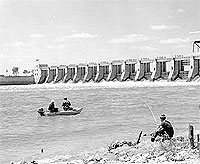 People bass fishing at the Jim Woodruff Dam. Photo courtsey Florida Photographic Archives. |
Miscellaneous Historical Items of Interest
There was a close connection between Jackson County and Apalachicola and St. Joseph. Peter W. Gautier, Jr. the editor of the St. Joseph Times, was originally from Marianna. John Gorrie (inventor of the ice machine) and Alvin W. Chapman (a famous botanist) married young Jackson County widows. Numerous Jackson County residents frequented Apalachicola for business (e.g., cotton). Gautier promoted Jackson County as a summer resort and during the yellow fever epidemic in 1841 many St. Joseph and Apalachicola residents stayed in Marianna.
Steamboats are a part of the pioneer panorama of the region. In spring of 1828, the steamboat Fannie's sailed from the Gulf of Mexico to Columbus, Georgia. The Virginia arrived a year later. Around 1849, there were 16 steamboats sailing up and down the river. Many of these boats were destroyed by boiler explosions or sunk by striking reefs. During the Civil War the steamboats were used to transport Confederate troops.
There was debate during the early territorial period as to whether Jackson County should be part of Florida or Alabama. Alabama decided to accept statehood in 1819 with its southern boundary at the 31st parallel rather than try to acquire west Florida and delay (and potentially jeopardize) its admission to statehood. There were actually nine attempts by Alabama and west Floridians to annex west Florida to Alabama.
Many of the prominent antebellum families of Jackson County settled in or near Marianna from 1832 to 1842 around the natural bridge of the Chipola River and the Big Spring (Blue Springs) in the Greenwood community. The first Jackson County settlers came to “Chipola Country”, the region through which Chipola River drains. These settlers cleared the wooded hammocks for cotton, corn, and sugar cane.
Old churches in Jackson County in addition to the Campbellton Baptist Church include the First Methodist Church of Marianna, St. Luke's Episcopal Church, First Presbyterian Church (Marianna), First Baptist Church of Marianna, and Greenwood Baptist Church.
REFERENCES
Shofner, Jerrell H., 1985. Jackson County, Florida - A History. Jackson County Heritage Association, Marianna, Florida, 627 pp.
Stanley, J. Randall, 1950. History of Jackson County. Jackson County Historical Society. 281 pp.
Note: The content of the website has not been updated since 2005. The site remains online for it's value as legacy content and is unlikely to be updated.